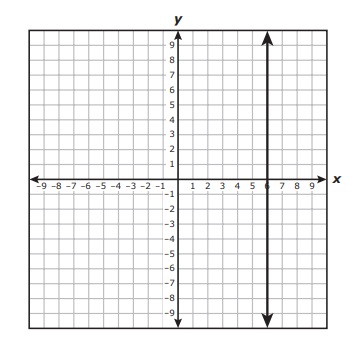More STAAR problems.
Administered May 2018
Read each question carefully. For a multiple-choice question, determine the
best answer to the question from the four answer choices provided. For a
griddable question, determine the best answer to the question.
31.Which expression is a factor of 21x2 + 13x - 20?
A 3x − 4
B 7x − 5
C 7x + 4
D 3x + 5
Answer: B 7x − 5
What are the factors of (ac) that add up to b?
(21)(-20) = -420. What factors of -420 have a sum of +13.
If you start with, say, -10 and 42, which add up to 32, you can see that you need to get the numbers closer together. -14 and 30 is +16, which is closer. -15 and 28 gives you the result you're looking for.
Rewrite 21x2 + 13x - 20 as 21x2 - 15x + 28x - 20
Now separate them and factor: (21x2 - 15x) + (28x - 20)
3x(7x - 5) + 4(7x - 5)
= (3x + 4)(7x - 5)
32. What are the equation and slope of the line shown on the grid?
F y = 6; slope is -1/6.
G x = 6; slope is zero.
H y = 6; slope is 6.
J x = 6; slope is undefined.
Answer: J x = 6; slope is undefined.
The slope of a vertical line is undefined. It is not zero. A slope of zero would be a horizontal line.
Vertical lines have equations like x = a, where a is the coordinate of the x-axis. There is no y in the equation.
Which function models the total number of metric tons of copper produced in the year that is
x years since 1900?
33. In the year 1900, the total number of metric tons of copper produced in the world was
495,000. Each year since 1900, the total number of metric tons of copper produced has
increased on average by about 3.25% over the amount produced the previous year.
A c(x) = 495,000(1.0325)x
B c(x) = 495,000(0.9675)x
C c(x) = 495,000x1.0325
D c(x) = 495,000x0.9675
Answer: A c(x) = 495,000(1.0325)x
If the amount has increased, then the rate will be over 100%. An increase of 3.25% means that the rate is 103.25%, or 1.0325, which is Choice A.
Choice B represents a 3.25% reduction every year. Choices C and D are meaningless nonsense, created by mixing up the elements of the function.
Record your answer and fill in the bubbles on your answer document.
34. What is the solution to 34x + 95 = 3(14x + 9)?
Answer: 8.5 or 8 1/2
34x + 95 = 42x + 27
95 = 8x + 27
68 = 8x
8.5 = x
35. The graphs of linear functions f and g are shown on the grid.
Which function is best represented by the graph of g?
A g(x) = f(x) - 4
B g(x) = 1/3 f(x)
C g(x) = f(x) - 2
D g(x) = 3f(x)
Answer: B g(x) = 1/3 f(x)
This is an interesting problem for me because it's not something that we encounter in New York in Algebra 1. In New York, when discussing transformations of functions, the focus is on translations, rigid motions, not dilations.
The first thing you notice about the graph is that the slope has changed, and the two lines intersect. This cannot happen in a translation, so Choices A and C are eliminated.
The new function has a smaller (less steep) slope than the original. Even without checking the points, it should be obvious that the slope must be 1/3 and not 3. If you check the graph, you can see that f(3) = 3 and g(3) = 1, f(6) = 6 and g(6) = 2. g(x) is 1/3 of f(x).
More to come. Comments and questions welcome.
More STAAR problems.



















No comments:
Post a Comment